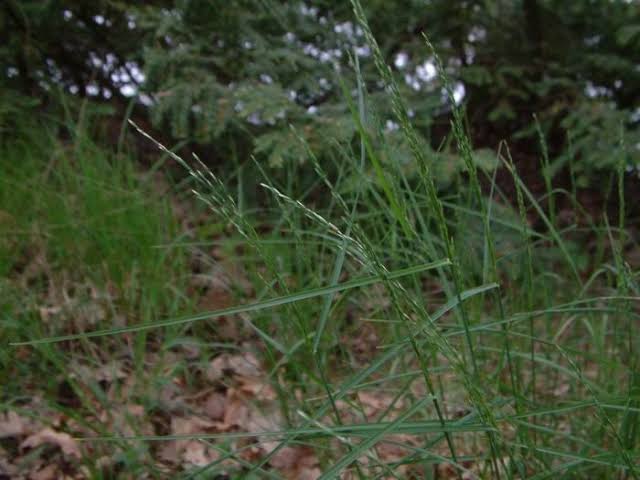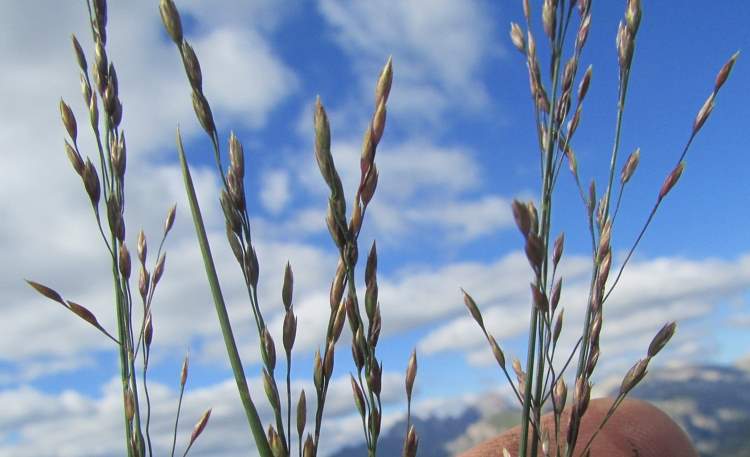Wood bluegrass (Poa nemoralis) is a type of grass that you can find in wooded areas. It’s a pretty plant with soft, green leaves. People often see it in forests or places with lots of trees.
This grass is special because it can grow in different places. You might spot it in the shade under the trees, where other grasses might find it hard to grow. Wood bluegrass doesn’t mind the shadows; it’s quite comfortable there.
One interesting thing about Wood bluegrass is that it’s not too picky about the soil it grows in. Some plants are very choosy, but not this one. It’s okay with different types of soil, as long as it’s not too dry. This makes it a resilient and adaptable little plant.
If you ever touch Wood bluegrass, you’ll notice that it’s soft. The leaves are gentle, not prickly like some other plants. It’s almost like nature’s own carpet in the forest.
This grass doesn’t usually stand out with bright colors. It prefers to blend in with its surroundings. The green of its leaves helps it hide among other plants, creating a harmonious look in the woodland.
Wood bluegrass doesn’t demand much attention, but it plays an important role in the ecosystem. It provides a cozy home for small creatures like insects and spiders. Birds might hop around it, searching for tiny bugs to eat. So, even though it might seem simple, Wood bluegrass is part of a complex web of life in the woods.
Next time you’re taking a walk in a forest, keep an eye out for Wood bluegrass. It might not shout for your attention, but its quiet presence adds to the beauty and balance of nature.
Read Also: Benefits of Constructing a Fish Pond with Tarpaulin and Woods
How To Grow Wood Bluegrass (Poa nemoralis)

Growing Wood bluegrass (Poa nemoralis) is a simple and rewarding process:
1. Choose the Right Location: Select a shaded area with trees, as Wood bluegrass thrives in wooded environments.
2. Prepare the Soil: Ensure the soil is not too dry. Wood bluegrass is adaptable, but it prefers a slightly moist environment.
3. Plant the Seeds: Scatter Wood bluegrass seeds over the prepared soil. No need to bury them too deep; a light covering will do.
4. Water Regularly: Keep the soil consistently moist, especially during the initial growth phase.
5. Be Patient: Wood bluegrass takes its time to grow. Be patient and allow nature to take its course.
6. Enjoy the Soft Touch: Once the grass has grown, appreciate the soft and gentle texture of the leaves.
7. Blend with Surroundings: Wood bluegrass naturally blends into its surroundings, creating a harmonious look in the wooded area.
8. Observe Wildlife: As the grass grows, observe how it becomes a home for small creatures like insects and spiders. It contributes to the ecosystem.
9. Minimal Intervention: Wood bluegrass doesn’t require much attention. Let it grow naturally and add to the beauty of its environment.
Growing Wood bluegrass can be a serene and uncomplicated experience, allowing you to witness the beauty of nature unfolding in your own backyard.
How To Care For Wood Bluegrass (Poa nemoralis)
Caring for Wood bluegrass (Poa nemoralis) involves simple steps:
1. Water Adequately: Ensure consistent moisture in the soil, as Wood bluegrass prefers a slightly damp environment.
2. Monitor Sunlight: Maintain a shaded environment, as this grass thrives in wooded areas with limited direct sunlight.
3. Avoid Overwatering: While moisture is important, avoid waterlogging the soil, as this can negatively impact the growth of Wood bluegrass.
4. Prune Gently: If needed, trim or prune the grass gently to maintain its appearance, but Wood bluegrass generally doesn’t require frequent pruning.
5. Observe Wildlife Interaction: Allow the grass to be a natural habitat for insects and spiders. Observing wildlife interaction adds to the charm of Wood bluegrass.
6. Appreciate Natural Beauty: Let Wood bluegrass grow naturally, appreciating its soft texture and its ability to blend into the surroundings.
7. Minimal Intervention: Avoid excessive interference; Wood bluegrass is resilient and doesn’t demand intense care.
8. Create a Woodland Environment: If possible, cultivate a woodland-like atmosphere to mimic the natural habitat of Wood bluegrass.
9. Enjoy Low Maintenance: One of the advantages of Wood bluegrass is its low maintenance nature, making it a hassle-free addition to your garden or wooded area.
Read Also: Stardew Valley Tilapia: Where to Catch them, their Uses, etc.
The Uses of Wood Bluegrass (Poa nemoralis)

Wood bluegrass (Poa nemoralis) has various uses:
1. Aesthetic Ground Cover: Enhances the visual appeal of wooded areas and gardens, providing a natural and soft ground cover.
2. Wildlife Habitat: Serves as a habitat for insects, spiders, and small creatures, contributing to the biodiversity of the environment.
3. Erosion Control: The root system helps stabilize soil, preventing erosion in areas with slopes or uneven terrain.
4. Natural Blending: Blends seamlessly into woodland environments, creating a cohesive and harmonious appearance.
5. Resilient Landscaping: Thrives in shaded areas and adapts to different soil types, making it a resilient choice for landscaping.
6. Soft Texture: Appreciated for its soft and gentle texture, adding a touch of comfort to natural surroundings.
7. Low-Maintenance Greenery: Requires minimal care, making it a suitable option for those seeking low-maintenance landscaping solutions.
8. Soil Improvement: Contributes to soil health by promoting a balanced ecosystem and supporting other plant life in the vicinity.
9. Educational Observation: Provides an opportunity for educational purposes, allowing individuals to observe and learn about the interconnectedness of plant and animal life in woodland ecosystems.
10. Conservation Areas: Often utilized in conservation efforts to restore and maintain natural habitats, as Wood bluegrass contributes to the overall health of ecosystems.
11. Green Roofs and Living Walls: Used in urban landscaping, green roofs, and living walls, where the grass can be incorporated to bring a touch of nature to built environments.
12. Recreational Areas: Planted in shaded recreational spaces or park-like settings, offering a soft and inviting ground cover for activities such as picnics or leisurely walks.
13. Environmental Education: Used as a subject for educational programs, showcasing the importance of native flora in ecological balance and conservation.
14. Traditional Medicinal Practices: In some cultures, certain grasses, including varieties of Poa, have been historically used for traditional medicinal purposes, although this may not be a widespread use of Wood bluegrass specifically.
15. Sustainable Landscaping: Fits well into sustainable landscaping practices due to its adaptability, requiring fewer resources and interventions compared to some other ornamental plants.
16. Botanical Research: Serves as a subject of interest for botanical studies, helping researchers and students understand the characteristics and adaptations of this particular grass species.
In essence, Wood bluegrass contributes to a range of ecological, aesthetic, and practical applications, making it a valuable element in diverse settings. Wood bluegrass, with its versatility, not only enhances the beauty of outdoor spaces but also plays a role in supporting a thriving ecosystem.
Frequently Asked Questions (FAQs)
Q: What is Wood bluegrass (Poa nemoralis)?
A: Wood bluegrass is a type of grass commonly found in wooded areas. It has soft, green leaves and thrives in shaded environments.
Q: Where can I grow Wood bluegrass?
A: Wood bluegrass is best suited for shaded areas, particularly in wooded environments. It can adapt to different soil types but prefers slightly moist conditions.
Q: Is Wood bluegrass high-maintenance?
A: No, Wood bluegrass is generally low-maintenance. It requires minimal care and can thrive in its natural environment without much intervention.
Q: Can I use Wood bluegrass in urban landscaping?
A: Yes, Wood bluegrass can be used in urban landscaping, especially in green roofs, living walls, or shaded recreational areas, adding a touch of nature to built environments.
Q: Does Wood bluegrass have any wildlife benefits?
A: Yes, Wood bluegrass serves as a habitat for insects, spiders, and small creatures, contributing to the biodiversity of the environment.
Q: Can I use Wood bluegrass for erosion control?
A: Yes, the root system of Wood bluegrass helps stabilize soil, making it useful for erosion control, especially in areas with slopes or uneven terrain.
Q: How fast does Wood bluegrass grow?
A: Wood bluegrass has a moderate growth rate. It may take some time to establish but is generally resilient and durable once established.
Q: Is Wood bluegrass suitable for educational purposes?
A: Absolutely. Wood bluegrass provides an opportunity for educational observation, allowing individuals to learn about the interconnectedness of plant and animal life in woodland ecosystems.
Q: Can Wood bluegrass be used in conservation efforts?
A: Yes, Wood bluegrass is often utilized in conservation areas to restore and maintain natural habitats, contributing to overall ecosystem health.
Q: Does Wood bluegrass have any traditional uses?
A: While not widely known for traditional uses, some grasses, including Poa varieties, have historical uses in traditional medicine in certain cultures. However, this may not specifically apply to Wood bluegrass.
Read Also: Waste Recycling Industry Trends: What You Need to Know
